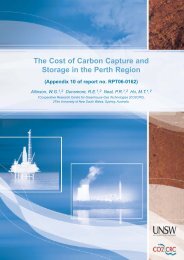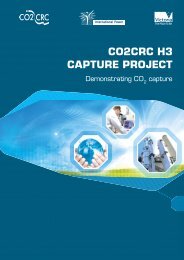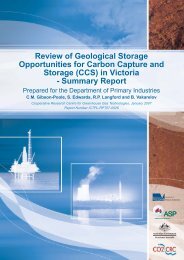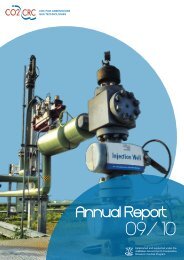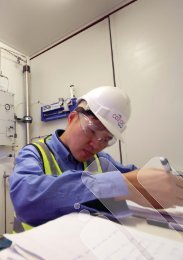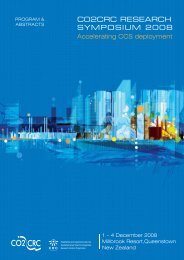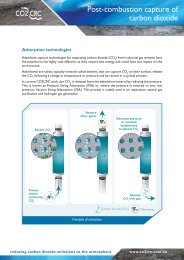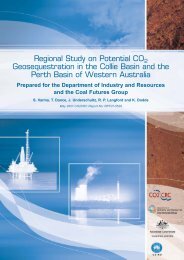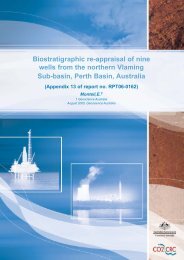Read the full report (PDF27.8 MB) - CO2CRC
Read the full report (PDF27.8 MB) - CO2CRC
Read the full report (PDF27.8 MB) - CO2CRC
You also want an ePaper? Increase the reach of your titles
YUMPU automatically turns print PDFs into web optimized ePapers that Google loves.
Table 5.1. Preliminary assessment of wells of <strong>the</strong> sou<strong>the</strong>ast Bowen Basin area.<br />
Well<br />
(north-to-south)<br />
Base of<br />
Precipice<br />
Sandstone (m)<br />
Top of<br />
Permian<br />
Section (m)<br />
Triassic<br />
Reservoir<br />
Potential?<br />
Permian<br />
Reservoir<br />
Potential?<br />
Juandah-1 1457 1994 No No<br />
Gurulmundi-1 1250 Not enough data No No<br />
Dulacca-1 1629 Not enough data Not enough data Not enough data<br />
Auburn-1 1618.5 Not enough data Not enough data Not enough data<br />
Miles-1 1228 Not enough data Not enough data Not enough data<br />
Columboola-1 1167 1185 No Not enough data<br />
Tey-1 1626 1626 No Not enough data<br />
Bennett-1 1714.5 1716 No Not enough data<br />
Undulla-1 1725 1737 No Minor Potential<br />
Leichhardt-1 1771 1790 No Not enough data<br />
Alick Creek-1 Not present 1640 No Minor Potential<br />
Tara-1 Not present 1639 No Not enough data<br />
Cabawin East-1 2384 3194 No Not enough data<br />
Cabawin-1 2326 3007 Minor Potential Minor Potential<br />
Tartha-1 2185 Not enough data No Not enough data<br />
Southwood-1 2082 2249 No No<br />
Cabawin-1 is <strong>the</strong> only well to have intersected a significant hydrocarbon accumulation. There are<br />
several potential sandstone–conglomerate reservoir intervals in <strong>the</strong> Triassic section of <strong>the</strong> well,<br />
which are thicker here than in any o<strong>the</strong>r part of <strong>the</strong> study area (Figure 5.1). These intervals have<br />
better porosity and permeability characteristics than o<strong>the</strong>rs in <strong>the</strong> study area, and are generally<br />
composed of quartz and chert pebbles with minor ash. However, <strong>the</strong>re is doubt about <strong>the</strong> volume<br />
of CO 2 that could be injected since <strong>the</strong>se sandstones have not been intersected in off-set wells.<br />
There are no obvious regional sealing units in this area, however a thickness of poor quality<br />
(in terms of reservoir) Triassic sequence could act as a significant baffle to vertical migration.<br />
Figure 5.1. Generic geological cross-section of <strong>the</strong> sou<strong>the</strong>ast Bowen Basin area. The cross-section shows<br />
distribution and thickness of Permian and Triassic sediments from north-to-south in <strong>the</strong> sou<strong>the</strong>ast Bowen Basin.<br />
Wells from north-to-south: Juandah-1 (also representing Gurulmundi-1, Dulacca-1, Auburn-1), Columboola-1<br />
(also representing Miles-1), Undulla-1 (also representing Tey-1, Bennet-1, Leichhardt-1), Alick Creek-1 (also<br />
representing Tara-1), Cabawin East-1, Cabawin-1, Tartha-1, Southwood-1.<br />
34


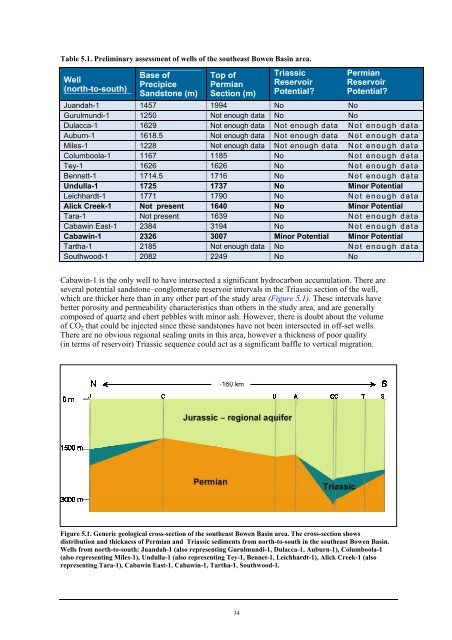
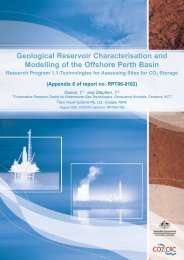
![Post-combustion solvent absorption [PDF 438KB] - CO2CRC](https://img.yumpu.com/48575763/1/184x260/post-combustion-solvent-absorption-pdf-438kb-co2crc.jpg?quality=85)

